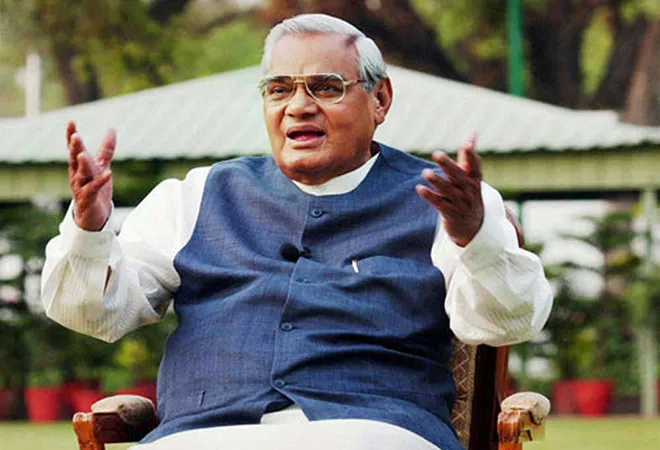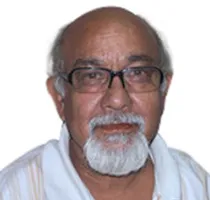-
CENTRES
Progammes & Centres
Location

Image Source: Deccan Herald
Tomes are being written over former Prime Minister Atal Bihari Vajpayee who was cremated on last Friday (17 August) with full state honour and millions paying him rich tributes. It would not be out of place to take a dispassionate look at the party, the Bharatiya Janata Party, (BJP) which grew under Vajpayee and his colleagues like Lal Krishna Advani.
The BJP was established in 1980 after a split in the Janata Party over the double membership issue, which boiled down to whether erstwhile Bharatiya Jana Sangh members in the party should be allowed to retain their association with the Rashtriya Swyamsevak Sangh (RSS). Vajpayee was elected its first president.
Since then, the new political party has been built with the toil and sweat of leaders like Vajpayee, Advani, Kushbhau Thakre, Sunder Singh Bhandari, Kailashpati Mishra, J P Mathur, Janakrishnamurty and lakks of dedicated and committed workers.
Vajpayee and his close companion Advani built the main edifice of today’s BJP that came to power in 2014 with a huge mandate. Experts as well as common citizens are in total agreement over this fact.
With Vajpayee as the first president, the new party declared that it would strive to follow the goal of ‘Gandhian Socialism’, with the objective of enlarging its mass appeal. In his presidential address at the first national convention of the party held in Mumbai in December 1980, Vajpayee underlined the “moral crisis” that India was facing. The three-day convention ended with Vajpayee’s call to the party to follow a three-pronged programme -- of sanghthan (organisation), sangharsh (struggle) and sanrachna (constructive construction). The convention stressed antyodayas, another Gandhian concept of reaching out developmental benefits to the poorest of the poor in the villages.
It is important to note that issues of minority appeasement, removal of Article 370 and the need for a common civil code did not figure on its political agenda. Under Vajpayee, the BJP presented itself to the people as a liberal force drawing its motivation from the Gandhian brand of socialism.
However, the BJP’s score of two seats in the 1984 general elections, held in the wake of the assassination of former Prime Minister Indira Gandhi, forced the party to abandon its objective of Gandhian socialism and return to the path of Hindu fundamentalism.
Advani came to head the party replacing Vajpayee in 1986. The BJP, like its earlier avtar, fell back on the support and guidance of the RSS and began to pursue ‘Hinduatva’. In his first presidential address at the party plenary session in New Delhi in May 1996, Advani said: “If anyone were to ask me which is the most distinctive trait of the BJP’s personality, I would say that the BJP is the voice of unalloyed nationalism. Ours is “Nation-First” party. It aspires to be the heartbeat of India”.
In the same breath, he denounced cow slaughter in many parts of the country and the destruction of as many as 45 Hindu temples in the State of Jammu and Kashmir although it was not wholly true. Advani declared that ‘for many politicians and political parties, secularism has become only a euphemism for political appeasement of minority sections which tend to vote en block. These politicians unabashedly propound the thesis that there is no such thing as minority communalism.
In 1989, at its party convention at Palampur, the party adopted a resolution deciding to participate in the Ramjanmbhoomi Mandir movement that had been launched in the 1980s by the Vishwa Hindu Parishad (VHP), an associate of the RSS.
In the 1991 election, the party increased its strength in the Lok Sabha to 120 from 85 in 1989. On 6 December, 1992, VHP and BJP leaders and workers demolished the Babri masjid. Vajpayee, in this phase when the party under Advani was aggressively pursuing Hindutva agenda, remained uncontroversial, maintaining his liberal image. Vajpayee was the most acceptable face in the non-BJP and non-RSS political circles.
The BJP’s strength further went up to 161 in 1996 and Vajpayee became the Prime Minister of the first government that lasted only 13 days but still the one a non-Congress leader led it.
With the party’s tally in the Lok Sabha going up to 182 in the 1998 general elections, Vajpayee formed the BJP-led National Democratic Alliance (NDA) government that lasted 13 months. The NDA returned to power in the 1999 elections and he again became the Prime Minister. The government lasted full five years. However, it lost the 2004 general elections. Vajpayee disproved the popular belief that non-Congress governments do not complete full tenure in office. It became possible because of the skills of Vajpayee who could carry along 22 allies successfully. His economic policies delivered and his foreign policy brought laurels to the country.
In BJP’s 24-year-long journey to power, while Advani had prepared the organisational architecture and building of the party, Vajpayee made it acceptable to non-BJP sections of the electorate.
Many non-BJP and non-RSS leaders like Yashwant Sinha, Arun Shourie, Sunil Shastri joined the party because of Vajpayee.
As an eyewitness to the growth of the BJP from 1988 onwards, when I started reporting about the party for an English news daily ‘Patriot’ and then for The Tribune, till 2008, I can authoritatively say that the top leaders of the party were accessible, friendly, willing to inform and compassionate to not only media persons but even to the party cadres and middle ranking leaders. There was an air of informality in interactions.
Even when the party came to power in 1996 and thereafter, party leaders did not shun media persons and returned their calls. Ministers met in their offices and residences and were willing to share news and views.
Nothing changed even after the party went out of power in 2004. The party under Vajpayee, Advani and others continued to be different till the BJP, for the first time, won majority in the Lok Sabha on its own in the 2014 elections.
The views expressed above belong to the author(s). ORF research and analyses now available on Telegram! Click here to access our curated content — blogs, longforms and interviews.

Satish Misra was Senior Fellow at ORF. He has been a journalist for many years. He has a PhD in International Affairs from Humboldt University ...
Read More +